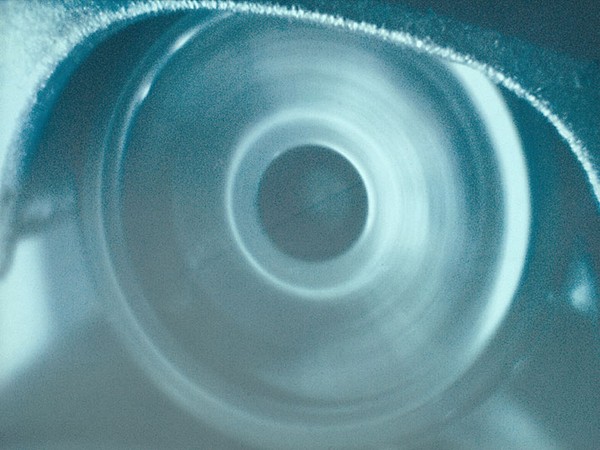By Jan Bryant
In Alex Monteith’s work there is an interest she shares with the writer Italo Calvino, in what can be seen in Calvino’s terms as a concern for deftness and lightness of touch; for what appears to impose restrictions on a work (forced restraints), instead open it out to infinite conceptual possibilities.
In this way, AV Scenario is a distillation of all the possible trajectories of film analysis and observation into one, formulaic shot. In Monteith’s capturing of this moment, the restaging and mimicking of a minute scene wrenched from a larger ‘whole’ (the spinning spoke of the car crash), the viewer is forced to notice what she or he might usually, in the flow of the narrative and in an over-familiarity with stock shots, overlook.
However, in the reversing of the spinning movement the viewer is forced to look differently about its referential foundation. Monteith’s image points only superficially to the original film referent — the reverse is not a re-inscription of the shot at all but an illusion (with hypnotic potential). It is at this moment, in our realisation that the shot has returned in a new way, that its former allusion (its singularity) is shattered into many planes of possibility. On one plane, the breaking up and dispersal of the visual surface through the circular movement of the lines on the screen, creates a captivating, abstract moving image, with meditative potential. This is just one possible reading of the image, one point within a range of multiplicities that opens the work out to infinite readings.
In the same way, it would be foolhardy to think that there may be a route back to the founding reference through the model car placed in the installation space (a form of closure). The original, which we must keep re-remembering exists only as illusion, is represented not by a ‘double’, but by a toy car, a miniature. The upturned model is disarming in the way of all mimicry for it unleashes another space with rupturing potential — all doubles, we are reminded, are impossible doubles, they all carry their points of difference.
Monteith’s installation, AV Scenario, playfully dismantles filmic illusion by picking away at the seamless coating stretched over the finished motion picture. Aside from reference to the apparent endless use of stock shots in motion pictures and the restaging and mimicking of minute scenarios that question film’s sense of ‘wholeness’, there is Monteith’s cheeky revealing of all the messiness of the production processes, the cables and pulleys, grips, cameras, and tripods. And, if as viewers we are happily complicit, if not demanding of our own manipulation in the illusion of filmmaking, then Monteith has replicated this manipulation by making the viewer initially see the image of spinning spokes as video projection, rather than as live-footage from a CCTV camera. Capturing as live action the wheel of an overturned model car is perhaps Monteith’s most puckish move for this reminds us of the trickery that produces the layers of simulation and illusion in all film production.
Set against such playfulness is the prosaic and overly descriptive title — Imitating the ‘spoke-backwards’ illusion during motion picture car chase scenes — and the careful, almost officious listing of each element that makes up the installation piece, laying-bare in another way, Monteith’s own thinking about the work of illusion.
AV Scenario is beguilingly playful and it is as much homage to Monteith’s love of all kinds of films, as it is an unpicking of its illusions.
Dr. Jan Bryant is Lecturer in Art History at University of Auckland. Her research focuses on the philosophical and political implications of modern and contemporary art, film and architectural practice, with particular interest in spatial theory and the city.


